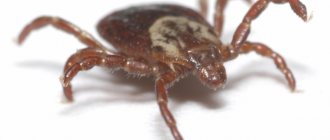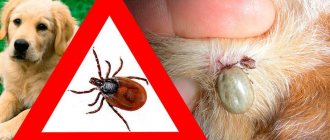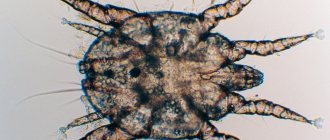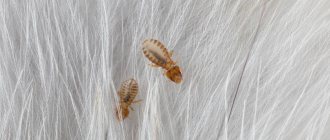Demodectic mange or subcutaneous mite in domestic dogs is a dangerous disease that is difficult to treat. At the very first stages of development of the pathological process provoked by parasites, the animal does not show concern.
The pet continues to eat normally, there is no weakness or lethargy, and physical activity remains. In some cases, with strong susceptibility, demodicosis may manifest itself as mild itching.
In the absence of timely treatment, the subcutaneous mite can weaken the body's defenses, becoming severe with further damage to internal organs. In advanced cases, the animal may die from demodicosis.
The main task of the owner is to promptly notice the characteristic signs of the disease and seek help from a qualified veterinarian. The first signs of demodicosis are noticeable on the skin. The disease should not be left to chance, even if it develops slowly.
Types of subcutaneous mites
Subcutaneous mites, unlike external parasites, live inside the skin. They live there throughout the animal’s life, their manifestation is provoked by various factors. In other words, pests may not make their presence known at all. The intradermal mite is Demodex, its habitat is the sebaceous glands and hair follicles.
The name of the disease caused by the subcutaneous parasite Demodex is demodicosis. It is one of the most common among four-legged animals, and it is also dangerous for people.
The following types of subcutaneous mites are distinguished:
- juvenile – manifests itself in puppies up to two years of age;
- adult – occurs in adult dogs.
Depending on the location of the lesion, demodicosis occurs:
- Localized. A certain area of the body suffers; the infected area has clear boundaries in which signs of a tick appear; it is usually located on the stomach, paws, and face. It is treated quickly, and remission often occurs after several weeks of therapy. Localized occurs in about 90% of cases.
- Generalized. It affects several parts of the animal’s body at the same time. In such cases, subcutaneous mites are often found on the paws. Treatment is longer, and in half of the cases it is not possible to completely get rid of the disease.
Scabies, a disease similar to demodicosis, comes in two types:
- Sarcoptic mange. The course of the disease is aggressive, symptoms quickly worsen without proper treatment. The manifestation is similar to the signs of demodicosis: the hair falls out rapidly, the animal suffers from severe itching.
- Notoedrosis. This is an ear parasitic disease accompanied by severe scabies. The dog scratches itself so much that blood and bruises often appear in the ears.
Scabies mites appear from the outside, but the manifestation of their presence, symptoms, and consequences for the animal are similar to demodicosis.
Diagnosis of subcutaneous mites in dogs and cats
If there are symptoms of the disease, then, of course, it is necessary to start treatment on time. Of course, the signs clearly indicate that your pet needs help and this needs to be done as quickly as possible.
However, making a diagnosis by eye is not recommended for several reasons:
- You simply may not have sufficient qualifications and knowledge to do this.
- You may simply make the wrong diagnosis and your treatment will not cure, but will simply allow the disease to develop unhindered for some time.
- Some types of ticks are simply so small that they simply cannot be detected with the naked eye, and this can lead to an incorrect diagnosis.
Suppose you observe itching, redness and even baldness in an animal. At first glance, it may look like an allergy or some kind of bacterial disease. In this case, treatment is often carried out with the help of various antihistamines and the itching subsides a little.
But at the same time, this may be an incorrect diagnosis. With this treatment, the disease will gain strength, and the reason for this will be an incorrect diagnosis. Only in the very first stages of the disease there are chances for a relatively quick cure.
Only a professional can carry out a real diagnosis. Treatment can also take place at home, but for this you need to know exactly what is happening to your dog or cat. First you need to get a scraping from the affected area. If you repeat it several times, this can increase the reliability of the analyzes performed. In the video below you can see what a tick looks like.
Signs of disease in a dog
The initial stage quickly develops into a complicated stage, with symptoms becoming intense. The main ones are:
- severe itching, the dog often scratches itself until it bleeds, hematomas may appear - paw marks;
- irritability, disobedience, refusal to follow commands;
- desire for privacy, the dog does not allow itself to be petted, and becomes aggressive when the affected area is touched;
- hair loss;
- redness of the skin, eventually becoming covered with scabs.
Both the physical and emotional state of the animal deteriorates; demodicosis causes discomfort and severe pain. Therefore, a caring owner will not delay in treating the dog.
To identify subcutaneous ticks in a dog at the initial stage, it is recommended to regularly examine the animal, comb it, and provide proper daily care.
Treatment of demodicosis and sarcoptic mange
Treatment of subcutaneous mites involves a complex effect. A course of medications will be required, as well as treatment of areas of the dog’s body affected by parasites.
General rules of treatment:
- Long-haired dogs are cut.
- The animal is washed with a special shampoo (preferably with an antiseborrheic effect).
- Purulent and ulcerative lesions are thoroughly cleaned and washed with a solution of hydrogen peroxide.
- The lesions are treated externally with antiparasitic drugs.
- The combination of a subcutaneous mite with an infection is additionally treated with a course of antibiotics.
- Along with medications, your pet should be given pre- and probiotics (to avoid problems with the gastrointestinal tract).
- A vitamin-mineral complex is prescribed to boost immunity and restore a healthy balance in the animal’s body.
Folk remedies are also used to treat areas affected by subcutaneous mites (necessarily in consultation with the treating veterinarian).
External means
Among the external agents used to treat diseased areas of skin on a dog’s body, the following are often prescribed:
- sulfur-zinc ointment;
- Amitan (solution for external use);
- Akarabor (ointment);
- Mitaban (liquid concentrate);
- Neo-Stomozan (liquid concentrate).
Of the antiseborrheic shampoos, Sulfoden will do the job well. External treatment with ointments and solutions is carried out several times a day according to the time schedule recommended by the doctor.
Injections
Complete destruction of the tick-borne parasite will require administering medications to the dog by injection:
- Immunoparasitan;
- Ivomek;
- Amitraz;
- Dectomax.
The treatment regimen is determined depending on the condition and weight of the dog.
Vitamins and diet
During the entire course of treatment, the pet needs strict nutritional correction and intake of a vitamin and mineral complex. The choice of professional food for the treatment period should be agreed with your veterinarian.
Dogs that eat natural food are switched to a hypoallergenic diet. The basis of a healthy diet:
- lean meat products (beef, veal, poultry, chicken eggs);
- dairy products;
- cereals: buckwheat, rice, egg, pearl barley (grain legumes are prohibited);
- vegetables, greens.
The products are boiled, stewed or steamed. In proportions, two-thirds of the meat ingredients should account for one-third of the cereals and vegetables.
The vitamin-mineral complex is prescribed by a veterinarian in combination with taking medications. Typically, it contains a higher dose of vitamin A, Omega-3 and Omega-6 fatty acids.
Look at the characteristics of the Mini Doberman Miniature Pinscher breed and find out who is suitable for an energetic dog.
The pros and cons of the French Bulldog breed, as well as the acceptable colors of the dog are written on this page.
Follow the link and read about the symptoms and methods of treating enteritis in dogs at home.
Folk recipes
Popular folk remedies for treating affected areas of skin on the animal’s body:
- A mixture of pureed sour apples and juniper berries.
- Tar soap, tar ointment (can be used once a week).
- Oil solution with celandine: dry plant roots are poured with an equal volume of vegetable oil and simmered for 4 hours at a temperature of 50-60 degrees. The resulting oil extract is applied to the skin of a sick dog once a day.
You can turn to traditional recipes when treating subcutaneous mites in a dog only in consultation with a veterinarian and after undergoing a medical diagnosis.
What are the dangers for humans and dogs?
Demodex, which lives on the fur of dogs, is transmitted to humans only in rare cases when his immunity is particularly weakened. However, even then the consequences will not be sad; the parasite will not live on the host’s skin for more than a few days. During this time, skin redness and itching may develop. This happens rarely, but for safety reasons it is recommended to handle a sick animal and care for it with gloves.
However, a person may develop another type of subcutaneous mite, also belonging to the Demodex class. The consequences of its appearance are serious. If left untreated, the skin in the affected areas becomes thicker, severe itching and redness appear. The most dangerous infection is accompanied by the appearance of pus. As a result, scars remain on the body for life, even after recovery.
Experts explain why subcutaneous ticks are dangerous for dogs. In addition to the deterioration of the general physical and emotional condition, there is a risk of infection in the affected areas. Ordinary dirt that gets onto an area of the animal’s body that has been combed can cause suppuration. Then you will have to deal with two problems at once.
Also, the harm of the subcutaneous mite affects the work of many internal organs: stomach, spleen, kidneys, and others. The risk of developing concomitant skin diseases resulting from scratching and inflammatory processes increases.
Cheyletiellosis (cheyletiosis)
The causative agent, the Cheyletiella mite, lives on the surface of the skin.
Peculiarities
Cheyletiellosis is contagious, occurs at any time of the year, has no breed or age specificity, but is recorded less frequently than other tick-borne diseases.
The causative agent of cheyletiellosis. Photo: Dr. Michael Dryden, College of Veterinary Medicine, Kansas State University
Can be transmitted to humans.
Symptoms of cheyletiellosis
The places where cheyletiellosis manifests itself are the upper part of the neck, ears and back, where sick dogs experience itching and redness of the skin, the formation of pustules, rashes, scales (another name for cheyletiellosis is wandering dandruff), then crusts that appear as a result of scratching.
Dandruff with cheyletiellosis
Hair loss may occur in affected areas.
How does infection occur?
The subcutaneous tick is transmitted from one animal to another. If the pet is contagious, and the owner neglects precautions, any, even short, contact with a healthy dog will cause infection. It doesn’t take long for parasites to move from one “victim” to another. They can jump over in a few seconds.
Representatives of no breed are immune from parasites. Knowing how dogs become infected with subcutaneous mites, you can try to prevent the disease as much as possible.
Many owners are interested in where ticks come from in a healthy dog. The reasons for the appearance are different, they are all associated with the rapid proliferation of Demodex in the skin. A favorable environment for them is increased sebum production. This is often due to deterioration of the skin condition that appears against the background of a weakened immune system.
When parasites are transmitted from one dog to another, dead skin particles and sebum are transferred. Along with them, a healthy dog receives parasites that quickly settle in a new place.
Diagnostics
Demodectic mange in dogs is not contagious to humans, since the causative agent of the disease in animals is one type of parasite, and in humans another. The disease is not transmitted from animals to people or from humans to pets.
Scraping
Before making a correct diagnosis, the doctor conducts a visual examination of the animal and scrapes from the deep layers of the affected epidermis.
During the procedure, the top layer of the dog’s skin is removed with a scalpel (until blood appears) and layers of the collected biological material are placed on a glass slide.
If several individuals of subcutaneous mites are found in the scraping, then a repeat diagnostic procedure is performed to confirm the final result. Single individuals in the analyzes indicate the development of a localized form of the disease.
With generalized demodicosis, a large number of parasites are found in the biological material.
Analyzes
Additional laboratory and instrumental tests are prescribed to animals to assess their well-being and determine the possibility of taking certain groups of medications.
The list of such examinations includes:
- blood test (general and biochemical);
- urine and stool analysis;
- ultrasound examination of internal organs (if necessary)
Treatment at home
It is not easy to remove subcutaneous mites; the disease progresses rapidly, so potent drugs are required. The duration of treatment depends on the severity of the disease and its timely detection. Usually it takes from 1 month. It is quite possible to carry out treatment at home, but the selection of medications should be carried out by a veterinarian who has confirmed the diagnosis.
For therapy to be successful, hygiene rules must be observed. All personal belongings of the animal must be thrown away; parasite eggs remain on them; the appearance of new mites makes any treatment useless. It is also necessary to treat the booth if the dog lives on the street. A solution of chlorophos (2 percent) is suitable for this. It is advisable to first treat it with a blowtorch fire and boiling water.
If possible, it is better to replace everything, even the booth, bedding, and floor of the enclosure.
Medications
The basis of treatment is the use of the following drugs, prescribed by many veterinarians:
- Bravecto. Insectoacaricidal drug of systemic action, administered orally. The tablets taste good, so most animals willingly eat it, otherwise the drug is forcibly injected into the mouth. The dosage is calculated individually, 25-56 mg fluralaner per kg of weight.
- Ivermek. A popular antiparasitic drug with a wide spectrum of action. On its basis, intramuscular injections are performed, the dosage is calculated individually. Typically, 0.1 ml of product per 5 kg of animal weight is recommended. Injections are given several times with an interval of 7-10 days.
Therapy requires complex treatment, so the following groups of drugs are prescribed:
- Immunostimulating. Immunoparasitan, which has several analogues, is considered effective. It is administered intramuscularly, the duration of use is about a week.
- Products for external use. It is important to use an ointment that has an acaricidal effect. The use of products in the form of sprays, gels, and creams is also effective.
- Medicines for the liver. The subcutaneous mite negatively affects the functioning of this organ, and therapy with potent drugs also negatively affects it. To maintain liver function, Karsil is often prescribed.
- Antihistamines. Help reduce unpleasant symptoms, severe itching, and discomfort.
Considering the load on internal organs, complex treatment of demodicosis includes following a diet. It is recommended to give the animal premium food, preferably hypoallergenic. When preparing food yourself, you must follow the veterinarian's instructions. Everything spicy, fatty, fried, and salty is excluded from the diet. Additionally, vitamins are prescribed.
Folk remedies
Treatment with folk remedies cannot be the only method of therapy. It can only be used in addition to drug therapy. The following recipes are common:
- Wormwood with honey. Take 100 g of dried plant and brew it in a liter of boiling water. After cooling to room temperature, add a tablespoon of honey. Give the dog half a glass before meals. To kill the smell, you can add more honey.
- Celandine. Based on this plant, you can prepare an ointment for rubbing into the affected areas of the skin. Grind the celandine root, pour in 100 g of sunflower oil, put on low heat for 3 hours. Cool, strain.
- Tar soap. It contains birch tar, which has a wound-healing and soothing effect. Gently apply it to the affected areas of the body and wash off with warm water after a few minutes.
Traditional methods are effective at the initial stage of the disease, when it affects a small area of the body.
Prevention
Animals that have already had demodex and have not yet encountered the disease need preventive measures. They imply compliance with the following rules:
- Proper nutrition. Often the immunity of animals is weakened due to the lack of a complete diet consisting of foods rich in vitamins.
- Vaccination. As the puppy grows up, all vaccinations required by age must be completed.
- Avoid contact with sick people. It is impossible to protect your pet from all infected animals, but it is important to stay away from strays that look suspicious.
- Antiparasitic agents. Before going for a walk, you can use drops and sprays, applying them to the dog’s fur.
Strong immunity is the main key to preventing infection. Such a dog, even if in contact with an infected one, will remain healthy, so it is important to provide the pet with a proper lifestyle.
Bitches who have had demodex are excluded from mating for breeding.
Subcutaneous mites in dogs are a dangerous disease that can, in a short period of time, worsen the animal’s general physical and emotional condition and ruin its appearance. Symptoms develop rapidly, and treatment should be started immediately after their detection. Prevention involves the use of measures to strengthen the immune system, limiting contact with sick animals, and observing hygiene rules.
Sources of infection
Demodex and scabies mites are ubiquitous. The main sources of infection in pets are:
- Animals suffering from demodicosis, sarcoptic mange and notoedrosis. Arachnoses are characterized by seasonal outbreaks in late autumn - early spring, when the frequency of contact between dogs and wild carnivores and rodents increases. If demodicosis and sarcoptic mange are most often carried only by sick dogs, then cats and rodents can also be carriers of sarcoptic mange.
- Care items. The causative agents of arachnosis can remain viable in the external environment for several days, so a healthy dog can become infected through contact with contaminated bedding, brush, or toy. Brand new care items just purchased from a specialty store can be contagious.
IMPORTANT!!! A loving owner can bring parasites into the premises from the street, so before contacting a pet, you must remove outer clothing and shoes, and wash your hands thoroughly with soap!
An exacerbation of arachnoses is observed in emaciated, weakened and young animals, after suffering from diseases, against the background of stress, metabolic disorders, neoplasms, poor quality maintenance and feeding.
Even one scabies mite causes the development of the disease; demodicosis manifests itself only when the following provoking factors act on the dog’s body:
- Vaccination;
- Weaning;
- Stress;
- Pregnancy;
- Puberty;
- Genetic predisposition;
- Oncology;
- Diabetes;
- Hormonal disorders;
- Heredity.
Conscientious breeders do not allow individuals suffering from demodicosis to be bred in order to avoid the spread of arachnosis.











